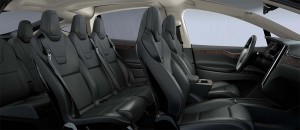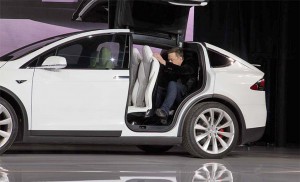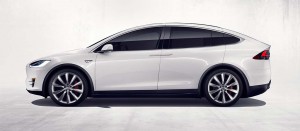After struggling to pull a “challenging” project together, Tesla Motors finally pulled the wraps off its new Model X sport-utility vehicle at a standing-room-only event in Silicon Valley.
It becomes just the third product line Tesla has ever offered, and the second in its current portfolio, a much-needed counterpoint to the Model S sedan in a market that has widely embraced utility vehicles. If all goes according to plan, the new Model X should help Tesla nearly double its sales next year and set the stage for the even more mainstream Model III due out in 2018.
As the California carmaker has attempted to do with the Model S, the new SUV delivers far more range than what other battery-cars can muster. And it’s loaded up with an assortment of surprise-and-delight features – from high-performance “Ludicrous Mode” to an advanced air filtration system CEO Elon Musk jokingly dubbed its “bio weapon defense mode.”
“People are going to get an incredible car that does so many things that no other car does, but it didn’t need to do quite as many things,” suggested the South African-born entrepreneur during the debut in Fremont, California, where the Model X is now rolling down the assembly line along with the Model S.
Tesla expects to finish this year delivering between 50,000 and 55,000 battery-cars. It hopes to get production up to around 1,800 a week in 2016. That’s actually a bit less than the Fremont plant – a one-time Toyota/General Motors joint venture – can handle. “We only want to deliver great cars, so we don’t want to drive to a number that’s greater than our ability to deliver high-quality vehicles,” recently explained.
Nonetheless, that should help prop up its balance sheet which has suffered a string of losses, at least according to traditional accounting methods. Development of the Model X proved to be far more “challenging,” in Musk’s words, than anticipated. The new SUV comes to market four years after it was first previewed – and two years later than originally planned.
(Mercedes takes aim at Tesla with 311-mile battery SUV. Click Here for the story.)
Visually, it hasn’t changed much from the original prototype, Tesla opting for a coupe-like crossover shape that might not generate much notice rolling down the road – but for its virtually silent electric drivetrain. When it will turn heads is when it’s time for passengers to exit the two back rows. Musk himself showed off the process, popping open the Model X’s “Falcon doors” from the third row.
The doors are a variation of the gull-wing doors occasionally seen on exotic sports cars such as the Mercedes-Benz SLR. Here they fold slightly when opening so they can operate in tighter and enclosed spaces, such as a garage.
The first few Model X utes will be part of a limited Signature Edition that will go to early customers who have, in some cases, been waiting more than two years to take delivery. As with the Model S, a variety of different versions eventually will be offered, but the Tesla website lists just two to start with: the Model X 90D, and the performance-oriented P90D.
Both will use a 90 kilowatt-hour lithium-ion battery pack slotted into the load floor of the SUV. In the Model X 90D, that will provide enough power for an EPA-rated 257 miles per charge. Two motors, one for each axle, will create an electric version of all-wheel-drive. The package makes 259-horsepower from each motor and will be capable of launching from 0 to 60 in 4.8 seconds, according to Tesla, and hitting a top speed of 155 mph.

The interior of the 7-seat Tesla Model X is both roomy and high-tech, the SUV borrowing the huge touchscreen control system of the Model S.
The Tesla Model X P90D will get to 60 in just 3.8 seconds – or 3.2 second if ordered with the optional Ludicrous Mode technology. It can churn out 259-hp up front and a maximum 503-hp from the rear. The added performance trims range to 250 miles.
(Tesla ups the range of the Model X. Click Here for more on that story.)
Tesla has been vague about pricing, though the Model X is expected to carry a premium over the Model S sedan, and a loaded Signature Edition of the P90D, according to some reports, will reach as high as $144,000.
The luxury maker has found a willing market for high-end SUVs – a discovery that has spurred luxury competitors like Audi, BMW and Mercedes-Benz to begin work on their own offerings – but Tesla CEO Musk has stressed that his company sees the real opportunity to grow in a more mainstream segment. The company plans to officially introduce, and start taking orders for, its Model III sedan next spring.
Expected to go for around $35,000, production won’t begin for another two years however – even if Tesla can keep that development program more on track than it did with the long-delayed Model X.
(Tesla set to show, begin taking orders for, Model III. Click Here for more.)




“OK kids, you have to get out of the back before daddy pulls into the garage.”
A few zero to sixty runs and the range drops to under 100 miles per charge. Why would someone pay almost $150K for a Tesla when they can buy a lot of Mercedes, Audi, BMW, Caddy, Porsche or other cars that retain their value, usefulness and can go farther than 100 miles before dying on the side of the road after a few zero to sixty runs? If Tesla can’t make money on the model S even with creative accounting, they will still struggle to be profitable with the model X. From the looks of it Tesla didn’t spend any money on model name research either.
I’m afraid that this may be the death kiel for Telsa. Never has any company that produced a gull wing door on a vehicle ever survived production other than perhaps some high price supercar.